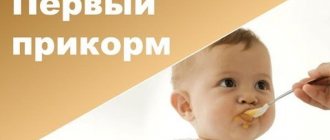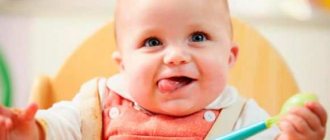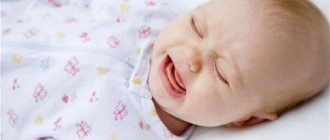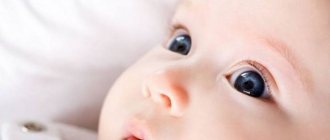Every parent eagerly awaits the baby's first word. No less, mom and dad rejoice at the first sounds their child makes. Such attempts to talk with other people are the first and very important stage in the development of a newborn’s speech. Humming prepares the articulatory apparatus for the reproduction of individual syllables, and subsequently words and phrases. However, in some cases, children stop walking at 3-4 months for no apparent reason or do not begin to do so at all. The article will talk about why the child stopped talking at 3 months, what are the possible reasons, what to do in this case, and how to develop the baby’s speech apparatus.
Regular communication with your baby contributes to the proper development of his speaking skills
The importance of a child's ability to walk
The first sounds that a baby makes at the age of 1-2 months are called humming. The importance of this skill cannot be overestimated. One of its most important functions comes down to communication between a newborn and the people around him: dad, mom, grandma, grandpa. The second significant point is that humming indicates the normal development of the child, namely the neurological health of the baby and the development of speech.
The development of the ability to speak can be divided into several stages: in the first weeks the baby coos, a month-old baby begins to babble, then his “speech” turns into babbling and by 12 months the little one can pronounce individual words (most often these are “mom”, “dad”, "woman").
Interesting. Many adults do not even suspect that children acquire language skills a month before they are born, in particular, they can distinguish languages by rhythm. The child masters basic knowledge of native speech (intonation, structure) already in the first months after birth.
To be more precise, humming is the baby’s utterance of various sound combinations. Mainly, the combinations contain the vowels “a”, “u”, “s”, as well as the consonants “m” and “g”, “p”, “b”, “k”. This is exactly the kind of “speech” that parents hear from their child in the first months of life (in addition to crying and groaning).
In addition to the functions mentioned above, cooing and humming perform another important task: they help the baby develop facial muscles, so that in the future the child will be able to pronounce clearer and more complex sounds.
On a note. Most often, infants begin to conduct stormy monologues when they feel full and satisfied.
Walking does not constitute an independent conversation - it is nothing more than repeating the speech of adults. This is exactly how the initial stage of formation of the reflective form of speech occurs. Many parents do not understand this and think that their child has learned to talk. Imitating parental articulation, the baby pronounces simple sounds and puts them into equally simple combinations. The main task at this stage is to make the transition to conscious perception and reproduction of linguistic elements.
Buzzing is a child repeating parental speech in a simplified form.
How the baby coos
Moms are often concerned with the question “At what months is the baby ready for verbal communication?”
In the first month, the child does not hear sounds or speech addressed to him. Already at the age of 1.5 months, the baby folds his lips into a tube, unclenches them and makes vowel sounds.
.
He pronounces them abruptly, in a sing-song voice, in a drawn-out manner, combining them together or separately. Later the labial sounds “m”, “p”, “b” are added
. From this moment on, it is believed that the little one began to walk.
The so-called “agu” occurs due to the structure of the baby’s speech apparatus and guttural sound pronunciation. When a toddler communicates, he listens to the sounds, as if he “freezes,” and then begins to intensively move both arms and legs and walk. The mother can stimulate the appearance of a “revival complex” if she invites the child to participate in the “conversation” in her friendly tone, while stroking him at the same time.
The child doesn't talk
When a child starts to gurgle and gurgle
If the baby was born on time and is completely healthy, humming should begin at 1-2 months. If after three months the baby still has not started to walk, there is a reason to consult a pediatrician, speech therapist, neurologist and otolaryngologist for advice.
However, you should not immediately think that the child is developmentally delayed. A slight delay is acceptable and should not be a cause for concern. A short delay is not always a sign of any disorder or pathology - some babies need a little more time to start walking (and therefore talking) than other children. At such moments, parents should be patient.
At 3 months
Why doesn't a child coo and gurgle at 3 months? If by this age the baby has not started to walk, there is no serious reason for concern. The child may need a little more time to learn new skills and begin to reproduce them (especially if the baby was born earlier than expected). However, to completely eliminate possible deviations, it would be a good idea to consult with a specialist.
At 4 months
At this age, children actively babble and begin to smile and laugh often. If by the end of 4 months the baby is not talking, this may be a sign of a speech development disorder. A visit to the pediatrician is necessary.
At the same time, if the baby started to talk before, but suddenly stopped, we may be talking about mastering new conversational skills. At 5-6 months, the baby will babble again, but at the same time use more complex and varied combinations of sounds.
At 5 months
In this case, there is probably a pathological reason for the delay in speech development. The child must be examined, an accurate diagnosis made and treatment started. At the same time, continue to actively talk with the baby and in every possible way stimulate the formation of his speech skills.
At 6 months
If by six months the baby has not started to walk, he needs to be shown to a pediatrician, otolaryngologist and teacher of the deaf. There is a high probability that the cause of the delay in speech development is hearing impairment.
At what months does a baby begin to coo and smile (laugh)
You can learn from mothers and from literature that there are two “terms” - humming and cooing (or hooting). How are they different from each other? Basically, nothing. Pay attention to how the baby behaves in your presence, when you talk to him affectionately and smile at him.
.
How many months a child begins to gurgle and how quickly he develops depends on you, the adults. Children are very susceptible to the attention of family members
.
You can't be silent with a child
.
And even if he doesn’t understand the meaning of your speech yet, he can really distinguish intonations
.
The timing when premature babies begin to cackle is no different from the standard ones - after 1 month of life. But only if there is a calm atmosphere in the family and attention
. The age at which children begin to coo varies. And the late onset of cooing does not indicate a child’s low intelligence or mental disorders.
Try to smile at the child, say a few gentle words, call him affectionately by name, and you will notice that the child is chattering - actively moving his arms and legs, smiling and drawlingly pronouncing “aguuu”, “auuuu” and similar combinations of predominantly vowel letters. Active movements are called the revitalization complex
.
It appears in the second month of life
.
Although the first quiet “ahu” can be heard earlier, from about 3 weeks from birth . Any healthy baby should start cooing by 3 months. From 3 to 5 months, the number of sounds pronounced becomes more and more diverse. More consonant letters and their combinations appear - “kh”, “gh”,
etc.
etc. From 5-6 months, babbling appears, it replaces cooing - this is when the child repeats different syllables - “ma-ma-ma”, “tya-tya-tya”,
etc. d.
When a child coos, he usually smiles. Often, from a very early age, children choose their “favorite” in the family, who they smile at more often
.
And usually it is not the mother or the father who becomes such a favorite, but the eldest child. The baby begins to laugh out loud later, from 3-4 months. Although sometimes you can hear the sounds of laughter earlier, when he is sleeping and, apparently, has colorful and good dreams
.
More often children laugh out loud, in whose families it is customary to laugh loudly
. They copy adults.
Why did the child stop walking?
Why does a child cry while bathing - what to do?
Sometimes it happens that the little one suddenly stops walking and starts mooing. In this case, there is no need to worry - according to pediatricians, the pause that occurs is most often associated with learning and mastering new conversational skills. By 5-6 months, the child moves to a new stage of speech development. At this age, the baby begins to babble and put sounds into more complex combinations (“ba-bo-boo” and the like). Therefore, it is not surprising that in order to achieve a higher conversational level, the child stopped cooing and cooing at 4 months and shows particular interest in the articulation of adults, trying to remember it and imitate it in the future. After some time, silent attention focused on the movements of the parent's hands and lips will be replaced by cheerful humming. At the same time, baby babble will be filled with new sounds, as well as their combinations.
On a note. If a child stops gurgling at 3 months, this may be due to a change in environment or other events in the life of the family that greatly affect the child’s emotional state (arrival of guests, visit to the doctor, long trip, etc.).
Many parents get scared when their baby suddenly stops talking.
Stages of speech development in the first year of life
Starting from 1.5 months, the mother begins to actively talk with the baby, responding to his “aha”, thereby attracting his attention. Up to 4 months, children readily try sounds by ear and joyfully share them with others.
First half of the year. The child develops and develops speech hearing. He knows how to talk about his problems using different tones of voice.
2nd half of the year. Children can not only walk, but also communicate using a combination of sounds, so at 7 months the mother understands her baby well and responds to his requests. Babbling appears, which the baby's mother encourages her to repeat by creating noise or using musical toys. Ringing toys for a 1-year-old child should not be too loud and frightening.
End of 1 year. How many words a baby should speak is a purely individual concept
.
But the children already understand the meaning of several dozen words, continue to hum, and the parents finally hear the child’s first words
.
By the end of 1 year, children develop independent speech. It usually consists of simple words
. A child of these years already consciously uses them in speech and begins to establish the simplest connections. During this period, every mother strives to teach her little one a long-term constructive dialogue.
Possible problems
Why doesn't a 3 month old baby roll over onto his stomach?
In certain cases, the absence of humming or its sudden cessation may be caused by certain problems, for example:
- Babies born prematurely often begin to speak later than others. It is obvious that the speech skills of such children have not yet reached the level of development that is characteristic of infants born at term. Therefore, they need time to catch up;
- Pathologies that a child was exposed to while in the womb or immediately after birth can cause delays in the development of the speech apparatus. Infectious diseases suffered by a pregnant woman have a similar effect;
- A pregnant mother taking medications, the side effects of which can negatively affect the child’s development of speech skills;
- Insufficient baby weight at birth;
- Poor baby health;
- Autism spectrum disorders. Such violations are characterized by a small vocabulary. However, not all disorders of this type lead to delayed speech development;
- Hearing impairment. The baby learns to speak by perceiving the speech of others using hearing. If disorders occur in this area, speech development becomes impossible;
- Neurological disorders, which include cerebral palsy, congenital mental retardation, speech apraxia (inability to control the movement of the jaws);
- Behavioral problems (selective muteness). Very rare.
How to develop a baby at 5 months
Exercises and activities with your child
Special time is allocated for conducting classes in the child’s daily routine for 5 months. They are carried out only against the backdrop of a favorable emotional state of the baby. If he feels unwell or is capricious, then it is better to postpone classes until a more favorable period. Classes are held after feeding, during the waking period: from 10.00-10.30 and from 13.30-14.00, the duration of classes should not exceed 5-7 minutes.
Great teacher V.A. Sukhomlinsky said: “A child’s mind is at his fingertips.”
In the human brain, the centers responsible for the movement of fingers and speech are located quite close. By developing hand motor skills, neighboring zones responsible for speech and thinking are activated in the cerebral cortex.
How to develop hand coordination and motor skills in a 5-month-old baby? There are special exercises for this.
Considering that the baby can lie on his stomach for a long time, resting on his palms, you can make a special aid: sew a small flat pad measuring 20 by 40 cm and no more than 1.5 cm thick. You will need an additional set of covers made from fabrics of different colors and structures (fashion, satin, oilcloth). On the reverse, “neutral” side of the cover we sew a variety of flat buttons: oval, round, square, large and small. Lying on his stomach and resting on his palms, the baby's hands will be on the surface of the pad. Taking the child's hand by the wrist, the adult runs his palm over the surface of the manufactured pad, encouraging the baby to feel it.
This exercise is used to develop research skills and tactile sensations of the hands.
Maria, mother of 5-month-old Ilya: “I sewed a pillow for my son with a set of different covers, and sewed buttons on the back side. Lying on his stomach, he examines her with pleasure. Ilya likes the multi-colored field with buttons. He pats the pillow with his palm with pleasure and tries to grab them with his fingers. When I turn the pillow over to the other side, my little son looks at it for a long time and runs his palms over the surface, as if he is trying to feel the missing buttons!”
Forming crawling and walking skills
To prepare a child for crawling and develop the skill, you need to put the baby on his stomach and place a bright toy or any other object that arouses his interest a little distance from him. Any attempts by the baby to get closer to the toy must be encouraged and encouraged.
You can sew a string to the toys and slowly pull it. The child becomes interested and will crawl after the toy.
Educational games with a 5 month old baby
With the help of educational games, the baby gets to know the world around him, learns to act with objects and establish relationships between them.
Games with hanging toys
Using a classic mobile, you can teach your child to perform two interrelated actions that lead to a certain result. The adult encourages the baby to reach for a certain toy. Having grabbed it, the child begins to pull it towards him, thus changing the location of the toy that is nearby.
You can invite your child to pull the ring suspended on a string from the bell. A bell attached to a mobile or bedside will begin to sound. This way the baby will master a simple action that has a result.
Games with rattles
An adult should teach the baby to take a rattle from his hands and from any position of the body, holding the rattle in his hand for 1-2 minutes. Focusing on a bright toy lying on the side, you need to provoke the baby to roll over from his stomach to his back and vice versa.
Games with tumblers
Playing with non-falling and pleasant-sounding toys helps your baby develop visual, auditory perception and hand coordination. At the sound of the tumbler, the baby turns his head and tries to reach it. Be sure to accompany your actions with the question: “Where is the tumbler?” - this is how the child learns to remember the names of surrounding objects. At first, you can tie a string with a ring to the tumbler. By pulling the ring, he will set the toy in motion.
Word games
There are many nursery rhymes, songs, games and toys that can entertain and amuse your baby! For example, the nursery rhymes “Okay, okay”, “Magpie-White-sided” force the child to listen to the adult’s speech and follow his actions. An adult, holding the baby in his arms, imitates the movements (claps his hands, runs his finger over the palm and bends one finger after another). The famous game “We shared an orange” amuses all children without exception:
We shared an orange (we squeeze the baby’s hand into a fist)
There are many of us, but he is alone.
This slice is for the hedgehog (we begin to bend the child’s fingers one by one)
This slice is for the swift,
This slice is for ducklings,
This slice is for kittens,
This slice is for the beaver,
And for the wolf - the peel. (straighten your palm and shake it)
He is angry with us - trouble!!!
Run away in all directions! (spread both palms in different directions)
How to promote the development of humming
If a child at 3-4 months does not make a lot of noise, parents can do the following:
- Talk to your child as much as possible. At the same time, it is worthwhile to diversify communication: use different intonation, change the tempo of speech. The child will try to repeat after the adult, thanks to which his speech will reach the next stage of development.
- The baby needs to regularly read books, recite rhymes, nursery rhymes, fairy tales, sing lullabies and ditties.
- The development of humming (and, accordingly, speech) is also promoted by massage and exercises.
- Take regular walks with your child. By gaining new impressions and observing the people around them, the baby will be able to quickly adopt skills and improve existing ones.
- Fine motor skills training. To do this, you can put various objects, such as toys, in the baby’s hands. A mobile above a stroller or crib will also stimulate the baby's grasping reflex. The fact is that the formation of speech is very closely related to the development of subtle movements.
- At the age of 2 months, you can begin to stimulate speech activity. Exercises are carried out for 1-2 minutes up to 3-5 times a day. The child is placed on his back, with a cushion placed under his neck, the baby's legs should be bent at the knees, the arms should be bent at the elbow joint and placed to the chest. The vocal response is also induced using breathing exercises in combination with vibration massage of the chest. In addition, there are the following methods for stimulating humming:
- They talk to the child in a gentle voice or sing to him. In this case, the baby must focus his attention, both visual and auditory;
- The baby is placed in a position that is comfortable for him so that the baby looks at the adult’s face. Next, you need to slowly pronounce simple sounds (“a”, “gu”, “aha”, etc.). At the same time, the mouth opens wide, vocal signals are pronounced clearly (so that the child can repeat after the adult). Another way to activate humming is to make sounds and at this moment stroke the baby’s lips and slightly open his mouth. The listed exercises are performed four to six times during the day.
Important! To achieve success in developing a child’s buzzing behavior, it is necessary to create an environment that is favorable from a psychological point of view. To do this, it is necessary that all family members have a positive emotional attitude.
Exercise to stimulate buzzing
Also recommended:
- Allow your child to experiment. Let the baby learn new words for as long as he needs and try to reproduce a variety of combinations.
- Remove sources of noise: turn off the TV and radio, close the window so that the little one can concentrate on copying and repeating voice signals.
Walking is the most important skill that every child should have in the first months of his life, since such a skill is a prerequisite for the correct development of speech in a baby. If the baby is not walking by the third or fourth month, it is worth showing him to the doctor (it definitely won’t be unnecessary). It is also necessary to develop this skill in the child on your own, trying to talk to him as much as possible and regularly carry out stimulating exercises.
What can I do to make my child start crying faster?
Many parents ask the question, how to teach a child to coo? When the baby begins to coo, parents can speed up this process - they should constantly talk to the baby, communicate, and not just care for it. A child, even a newborn, must be told fairy tales, sing songs, rhymes and nursery rhymes, paying special attention to carefully pronouncing sounds
.
A little patience - and the baby will begin to repeat the sounds he hears and coo
. How else can you help your child master the basics of speech skills?
- A huge role is given to the emotional component of communication between parents and newborn. It is necessary to communicate with the child in a calm, measured tone
. Under no circumstances should you scare the baby. It is necessary to maintain a calm environment in the house. - Development of fine and gross motor skills of the hands - the child can touch with his hands a variety of objects that differ in shape, texture and other characteristics.
- Parents need to actively gesture during a conversation, play finger games - for example, the well-known “okay” or “magpie-crow”.
- When talking with a child, parents should not lisp and distort sounds and words - children should learn correct pronunciation.
As soon as the newborn begins to speak his first sounds, mom and dad can play “repeat” with him. To do this, parents repeat all the sounds uttered by their children, gradually adding new, simple sounds or sound combinations to them - after all, at what months children begin to coo depends on the parents.
An important condition is a favorable environment. A happy, dry and well-fed newborn begins to coo and coo much earlier than a baby in a stressful situation.









